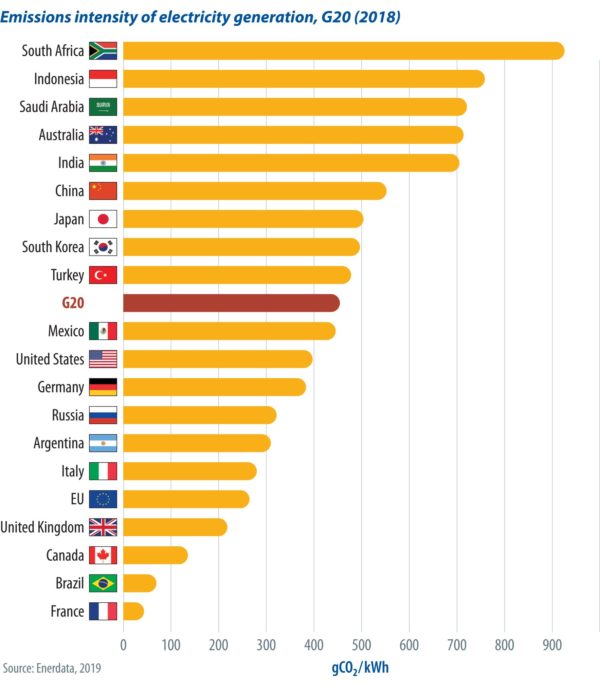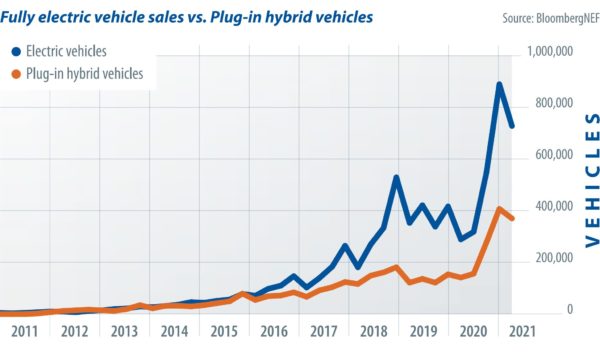From pv magazine 09/2021
To make the energy and mobility transition successful, we need to switch to vehicles with net-zero emissions. Net-zero refers to emissions at both the tailpipe of the vehicle, as well as the electricity power plant/source. And this transition is not just about zero emissions from new vehicles being sold, but the entire vehicle fleet.

The graph on p. 105 (top) shows the global sales of fully electric and plug-in hybrid electric vehicles, indicating a dramatic increase over the last decade. But to get to net-zero, there are several key challenges, especially in price-sensitive developing economies, as well as in developed economies. It is in this context that there is a significant opportunity for hybrid electric vehicles (HEVs) as we transition to 100% emission-free mobility. The opportunity for hybrids comes from the transition challenges we face.
Fast charging
First, the successful transition to fully electric vehicles (EVs) needs extensive EV fast-charging infrastructure in many places, including along highways. By fast charging, we are referring to power levels of 50-350 kW for cars (and up to 1,000 kW for heavy-duty vehicles). This will enable users to make long-distance trips using their EVs by stopping for 10 to 20 minutes to gain 300-400 km in range.
The lack of fast-charging infrastructure could be determinantal in motivating people to buy an EV. We have to bear in mind that people generally want to own one affordable car that should cater to both short and long-distance travel needs over the next five to 10 years, and want to drive without range anxiety.
Indicative prices for EV fast chargers are a capital cost of 500-1,000$/kW, service and maintenance 5%/year, and installation costs of approximately 50% of the charger cost.
The high cost and wide variation are mainly due to several factors, including the necessary high-capacity power connection, costs of a new transformer plus cabling and installation, service-level agreements, DC charger plug options (one or more of: Tesla, CHAdeMO, CCS/Combo, Chinese GBT, AC plugs), number of chargers installed at that location, costs for customization, and the necessary labor costs and permits.
The high costs of fast charging infrastructure and the need to “electrify” every highway, not just specific corridors, are significant costs for countries.
Grid decarbonization
As the graph (left) shows, many electrical grids are far from decarbonized.Well-to-wheel emissions of fully electric cars will only be drastically lowered if we move away from fossil fuels for our electricity production, and for many countries this process is going very slow. This ultimately results in the far lower emission benefits of total electrification of mobility.
In addition, large parts of the world, especially in developing nations, are missing access to a grid, or the grid is not yet 100% reliable. The relatively high power needed for EV slow charging (<22kW) and fast charging make the problem even more prominent on the distribution and transmission level. This has resulted in a severe amount of concern amongst grid operators and vehicle owners about whether to transition to battery EVs.
Furthermore, the mass-market price point of cars in the developing world is much lower at $6,000-12,000. While EVs with a range of 300-400 km will reach purchase price parity with conventional vehicles in the developed world at a price point of $25,000-35,000, this will still be unaffordable for the developing world. The high price of EVs continues to be driven by battery costs, ranging between $130-200/kWh at the pack level. And EVs with a higher range will need larger battery packs and hence have higher purchase prices.
Considering the above, HEVs (mild, full hybrids or plug-in hybrids) represent a massive opportunity to lower emissions in the interim period between the age of Internal Combustion Engine (ICE) vehicles and a future with fully electric vehicles powered by 100% renewable energy.
However, the dominant focus in media and industry is currently on fully electric EVs, which may not be practical in developing countries for years or decades to come; given grid reliabilities, expensive charging infrastructure requirements, and of course, prohibitive EV costs.
| Cars sold in US market, with fuel economy in miles per gallon equivalent (MPGe) | ||||
| 2021 model | Fuel economy in MPGe | |||
| City | Highway | City/Highway Combined | ||
| Conventional | Hyundai Elantra | 33 | 43 | 37 |
| Honda Civic | 32 | 42 | 36 | |
| Kia Forte | 31 | 41 | 35 | |
| Honda Accord | 30 | 38 | 33 | |
| Toyota Camry | 28 | 39 | 32 | |
| Toyota RAV4 | 28 | 35 | 30 | |
| Hybrid EV | Hyundai Ioniq | 58 | 60 | 59 |
| Toyota Prius | 58 | 53 | 56 | |
| Honda Insight | 55 | 49 | 52 | |
| Kia Niro | 53 | 48 | 50 | |
| Honda Accord | 48 | 48 | 48 | |
| Toyota RAV4 | 41 | 38 | 40 | |
| EV | Tesla Model 3 | 150 | 133 | 142 |
| Tesla Model Y | 140 | 119 | 129 | |
| Chevy Bolt | 127 | 108 | 118 | |
| BMW i3 | 124 | 102 | 113 | |
| Nissan Leaf | 123 | 99 | 111 | |
| 2021 model | City/Highway Combined (MPGe) | ||
| Electric | Hybrid mode Gasoline + Electric | ||
| Plug-in HEV | Prius PHEV | 133 | 54 |
| Kia Niro | 105 | 46 | |
| Honda Clarity Plug-in | 110 | 42 | |
| Chevy Volt (2019) | 106 | 42 | |
| Chrysler Pacifica | 82 | 30 | |
| Source: www.fueleconomy.gov | |||
There are several key technical and economic reasons that make hybrids attractive as an excellent interim step towards decarbonization:
The optimal matching of the ICE and electric power in a hybrid vehicle results in the ICE operating close to its optimal efficiency point. This results in the fuel economy of hybrids being 1.5 to two times higher than conventional ICE vehicles for city driving and one to 1.5 times higher for highway driving. The table above shows popular HEVs sold in the United States and their fuel economy in miles per gallon equivalent. Evident is the four to five times higher fuel economy of EVs compared to ICE vehicles.

Going further, a plug-in hybrid electric car combines the best of both the HEV and EV. Using a small battery (<10kWh) that can be charged from the grid can cover 90-95% of all short, day-to-day commutes in fully electric mode, with three to four times higher fuel economy than ICE vehicles.
Regenerative braking in HEVs, recovering the kinetic energy instead of dissipating it as heat can further improve fuel economy especially in urban areas with frequent stop-go patterns. Engine start-stop mechanism can save fuel in traffic lights and heavy traffic. Electric torque-assist can improve fuel economy in acceleration and hill-climbing conditions by ensuring that the ICE operates at its most fuel-efficient point while the electric machine provides varying power demand.
Finally, the purchase price of hybrid cars is not much higher than conventional vehicles; ranging between 15-25% higher, independent of the vehicle range.
EV, HEV, PHEV: Confused?
Any vehicle propelled by an electric drivetrain taking electric power from a portable, electrical energy source (like battery, fuel cell or solar panels) is referred to as an electric vehicle (EV):
- Hybrid electric vehicle (HEV): An internal combustion engine in combination with an electrical generator is used to produce electricity to power the electric drivetrain. Small batteries are used in HEVs to act as an energy buffer to store the electricity, but the batteries cannot be charged from the grid. A mild hybrid is a type of HEV in which the electric powertrain is not sized to fully propel the vehicle independently.
- Plug-in hybrid electric vehicle (PHEV): Still an HEV, but the battery is much larger and can also be charged from the electricity grid.
- Fuel cell electric vehicle (FCEV): A fuel cell using hydrogen, for example, is used to produce electricity to power the electric drivetrain, in combination with a small battery buffer.
- EV: A fully electric vehicle, also referred to as battery electric vehicle (BEV) or plug-in electric vehicle (PEV), which has no internal combustion engine. The battery is much larger with more capacity and can only be charged from the grid.
Want to learn more about electric cars?
The massive open online course (MOOC) for electric cars consists of four sections (Introduction, Technology, Business, Policy) for free on the edX platform. Each course is four weeks long, with a workload of four to five hours per week. The program has been very successful, with more than 165,000 registrations from 175 countries since 2018.
Sign up via www.tiny.cc/ecarsx
Two-wheeled solutions
Electric two-wheelers could transition to fully electric within a relatively short time span in many parts of the world. For example, in India, more than 70% of all registered motor vehicles are two wheelers. This is because they are typically used for short-distance commutes in urban areas, have a much lower energy consumption per kilometer than cars, and have lower requirements for acceleration and top speeds compared to cars. This means a small and hence cheaper battery of 1-3 kWh would be sufficient for a range of 60-100 km and the electric motor is rated for only 4-10kW, bringing down the purchase price. The small batteries also mean that fast-charging infrastructure is not needed.
The ideal future is one where all our electricity is made from renewable sources like solar and wind, and we power our EVs using solar energy in the day and wind energy at night. For those countries that can already work toward this goal now, the priority must be to realize this vision.
On the other hand, in places where transitioning to renewables and building fast-charging infrastructure would take a decade or longer, we need to seriously consider and move to hybrid electric cars as an intermediate solution, due to the fuel economy and emission benefits. With the effects of climate change already being felt globally, acting now is even more critical.
About the author
Gautham Ram completed an electrical engineering degree in his home city of Chennai, India, and won a scholarship to complete a master’s degree at TU Delft in the Netherlands. He subsequently completed a PhD on the topic of charging EVs with solar.
This content is protected by copyright and may not be reused. If you want to cooperate with us and would like to reuse some of our content, please contact: editors@pv-magazine.com.








Did any Country Manufacture Self Charging EV Vehicle’s ? Where You Don’t Need or Have to Visit a EV Charging Stations for Charging Your Vehicle Batteries ?
“We use 33.708 kWh as a reference, as it is the energy equivalent of 1 gallon of gasoline.” While there is a vague sort of logic in “energy equivalence,” the real significance for any device is work, which is entirely different (due to the inefficiency of internal combustion engines) and therefore this point is very misleading. Using a midsize car as an example, 33.7kWh will take it about 120 miles, and obviously that’s much further than the 30 miles that 1 gallon of gas will take that midsize car.